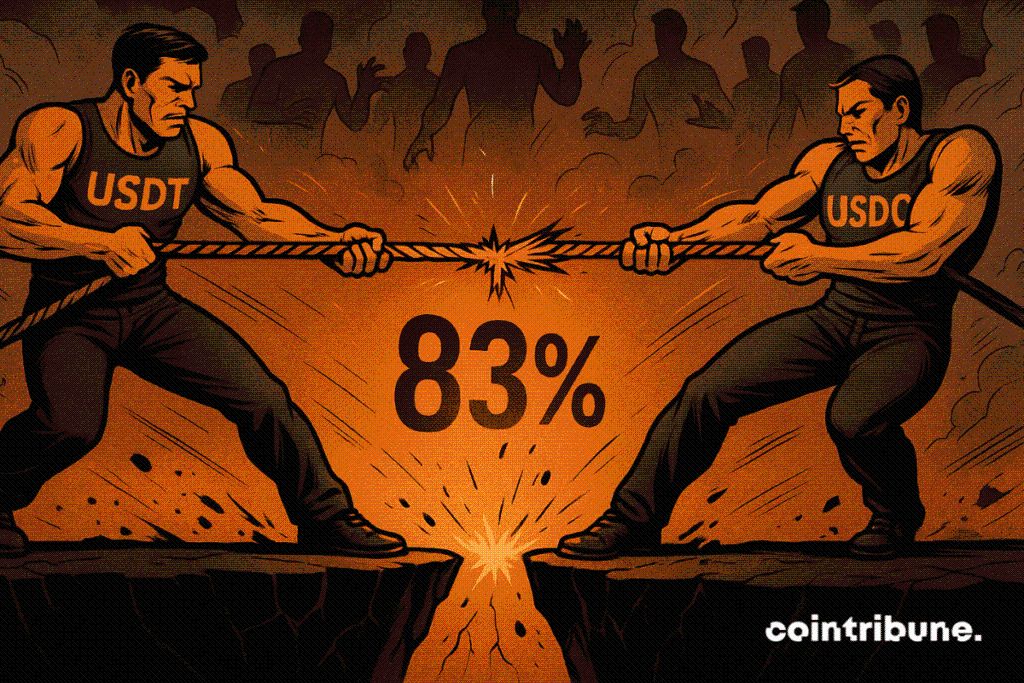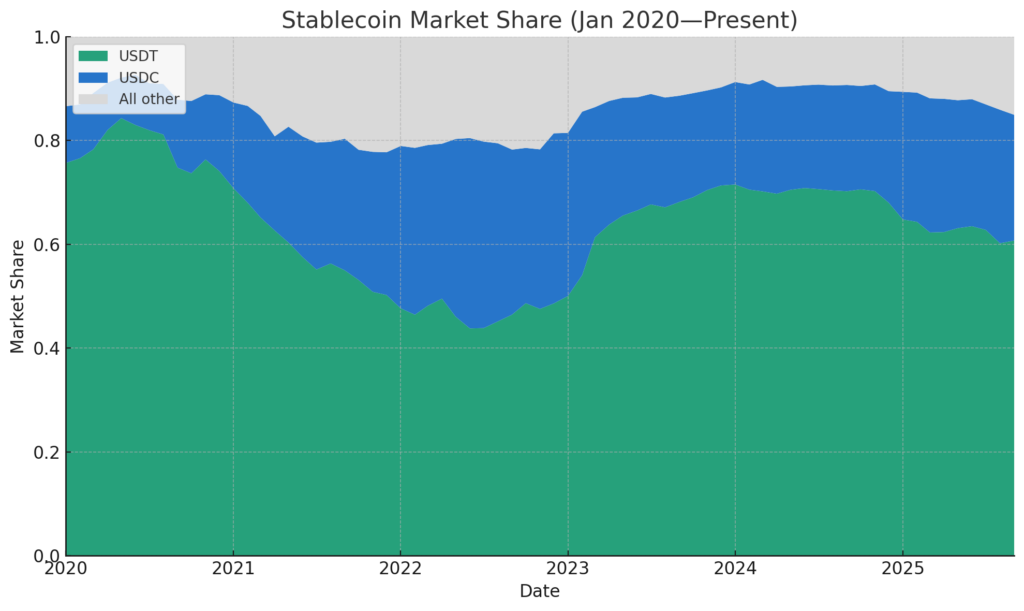Stablecoin Leaders USDT and USDC Lose Ground as Their Dominance Falls to 83%
Tether’s USDT and Circle’s USDC have long stood at the top of the stablecoin sector. For years, these two assets made up nearly the entire market, leaving little space for others. That landscape is now changing. Their combined share is slipping as new competitors, regulatory frameworks, and banks begin reshaping the field.

In brief
- USDT and USDC have seen their market share fall from 91% in March 2024 to 83% currently, signaling growing influence of rival stablecoins.
- These new stablecoins are attracting interest by offering yield to investors, providing viable alternatives to the traditional leaders.
- Major banks are also exploring entry into the stablecoin market through potential consortia, a move that could significantly reshape the sector.
Declining Dominance of USDT and USDC
The global stablecoin market was valued at over $140 billion, with USDT at around $103 billion and USDC at about $29 billion in March 2024, together accounting for 91.6% of the total supply and giving the two coins an almost complete grip on the market.
That dominance has begun to wane. Data from DefiLlama shows that USDT and USDC now account for 83.27% of the stablecoin market share , a decline of more than eight percentage points, signaling a slow but steady erosion of their control. Analyst Nic Carter points out that this downward trend is likely to continue, driven by rising structural and competitive pressures in the market.
New Stablecoins Compete Through Yield
Carter points out that the market now hosts a wider mix of established stablecoins than in earlier cycles. PayPal has released PYUSD, World Liberty introduced USD1, Ethena launched USDe, and Sky brought forward USDS.
Other names are also rising, including Ondo’s USDY, Paxos’ USDG, and Agora’s AUSD. These new projects have begun attracting investors and broadening the overall supply base.
Compared with earlier market cycles, he noted that “there are a lot more credible stablecoins than there were during the last surge, and they collectively have more supply than they did in the prior bull market – even against the backdrop of Tether and Circle continuing to dominate market share and liquidity.”
 Stablecoin market share over time: dominance of USDT and USDC
Stablecoin market share over time: dominance of USDT and USDC
What separates many of the newcomers is their ability to shift yield back to holders. In contrast, Tether provides no yield, while Circle offers only limited rewards through partners such as Coinbase. This makes newer stablecoins more appealing to holders seeking returns.
While the GENIUS ACT framework formally restricts stablecoin issuers from paying yield directly, it does not stop third-party platforms or intermediaries from offering rewards, often through arrangements with issuers. According to him, this regulatory gap has allowed yield-bearing models to expand, giving new entrants an advantage over established players.
GENIUS doesn’t actually prohibit third-party platforms or intermediaries from paying rewards to stablecoin holders (which are, in turn, paid to the intermediaries by the issuers).
Nic Carter
Stablecoin Competition Set to Grow with Bank Participation
Recent regulatory changes are also reshaping the stablecoin market by allowing banks and other financial institutions to issue their own coins. Carter notes that, while concerns about potential deposit runs persist, major banks are actively exploring entry into the space.
Earlier this year, JPMorgan, Bank of America, Citigroup, and Wells Fargo held preliminary discussions about forming a stablecoin consortium. He explained that “a consortium makes by far the most sense, as no bank individually has the ability to create the necessary distribution for a stablecoin which could compete with Tether.”
The potential participation of banks could significantly expand the market. Carter explains that their entry may overshadow the current $300 billion market and create a new layer of competition for existing stablecoins.
Disclaimer: The content of this article solely reflects the author's opinion and does not represent the platform in any capacity. This article is not intended to serve as a reference for making investment decisions.
You may also like
Paxos Purchases Fordefi to Enhance Institutional DeFi Growth Security
- Paxos acquires Fordefi for $100M+ to enhance DeFi custody, stablecoin issuance, and asset tokenization capabilities. - Fordefi's MPC wallet technology, securing $120B+ monthly volume across 90+ blockchains, will integrate into Paxos' infrastructure. - The deal expands institutional access to secure on-chain solutions for clients like PayPal and Mastercard amid rising DeFi adoption. - Paxos faces regulatory scrutiny after a $26.5M fine but aims to address institutional DeFi compliance challenges through t
Bitcoin News Update: Crypto ETFs Face a Pivotal Moment: Navigating Between Stability and Market Fluctuations
- Crypto ETFs faced $4B November outflows as Bitcoin/Ethereum prices dropped 27.4%, driven by retail selloffs and market corrections. - Coinbase bolstered security via routine wallet migration, warning users about phishing risks amid heightened sector vulnerabilities. - ETFs rebounded with $238M Bitcoin inflow (led by Fidelity/Grayscale) and $55M Ether inflow, signaling tentative investor confidence. - MSCI's delisting erased 45% crypto-treasury value, while institutional buyers "nibbled" amid uneven firm

Bitcoin News Today: "Transforming Isolated Gas into Bitcoin: The Energy Innovation of KryptoByte and Archax"
- KryptoByte partners with Archax to custody Bitcoin mined using UK stranded gas, enhancing institutional credibility. - The model converts undervalued natural gas into Bitcoin via low-footprint infrastructure, targeting €2.5M annual cashflow. - Industry trends show sector-wide diversification, with firms like Cipher Mining and 100MW securing $333M-$200M in funding for energy-efficient operations. - Strategic alliances highlight Bitcoin's integration with traditional energy assets, aligning with AI/HPC-dri

Security Concerns Hinder Nigeria's 5G Aspirations
- Nigeria's 5G coverage remains at 3% three years post-launch, lagging behind regional peers and global trends like MENA's projected 48% adoption by 2030. - Security crises, including 300+ schoolkid kidnappings, have diverted government resources from infrastructure, delaying 5G rollout amid economic instability. - Despite 15.7% annual fintech growth, Nigeria's embedded finance sector faces innovation limits without widespread 5G to enable real-time data processing. - Contrasting South Africa's 20% online

